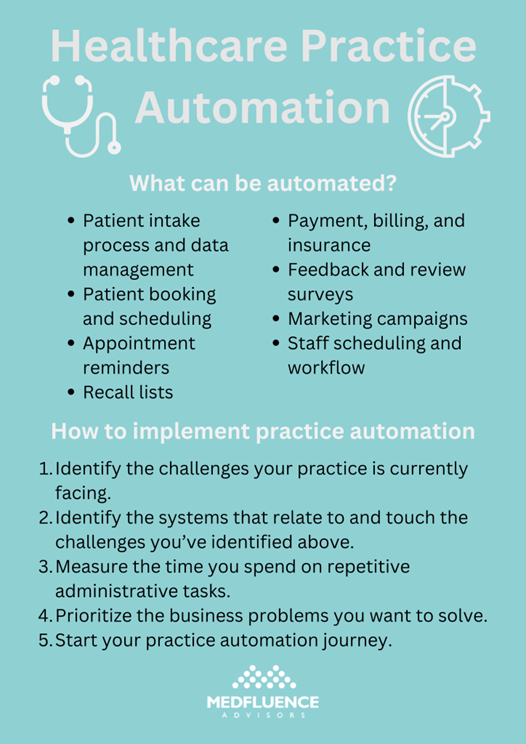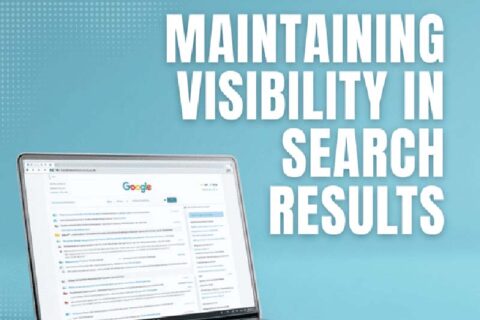Healthcare Automation: Is This Where We’re Headed in 2024?
Healthcare organizations are no exception to the many problems businesses face daily. Whether that’s numerous missed patient appointments, you and your staff drowning in so much paperwork, payment and billing errors, busy phone lines, or spending too much time on mundane tasks – anything can take a toll on your business operations. Additionally, the more time you and your staff need to spend on repetitive and administrative tasks throughout the day, the less time you get to spend with patients and on actual patient care.
Though your business pretty much needs it to continue operation, tedious (and often repetitive) administrative tasks take so much of your and your staff’s time and can instead cause inefficiency in the long run. This extra work can often make running your business practice much harder than it should be. This can affect the quality of your service and therefore will lower patient experience satisfaction; it will have a direct effect on your business’s profit margin.
What is the solution to these problems that continue to arise in the healthcare and medical service industry? Healthcare and practice automation.
With the right medical practice management software, your practice will flourish, providing exceptional service that keeps patients returning.
What Is Healthcare Automation?
Healthcare automation automates and streamlines often time-consuming and repetitive administrative tasks. Don’t get it wrong though, these tasks are still an important part of business operations and often keep the boat floating, but they do take a lot of time and effort on the staff’s part. This is where healthcare automation comes into play.
Healthcare automation uses bots and automation systems to make operations easier and less time-consuming. This can include keeping a detailed database of patient information, scheduling and booking appointments, filling out forms, billing and payment, data transfer, and more.
Implementing healthcare automation in your medical practice will increase efficiency and streamline a lot of the tasks that keep business operations afloat. It also makes things easier for you and your staff so you can focus your time and energy on other important tasks, like patient care.
Why Your Practice Needs It: The Benefits of Healthcare Practice Automation
Healthcare practice automation provides a lot of benefits for doctors and staff in your medical practice and for the patients who seek the services your organization provides. Here are all the benefits your healthcare practice can expect with the right operating system in place:
Save time
One huge obstacle many healthcare practices face is the amount of time spent on repetitive tasks. Though these administrative tasks are important to the business’s operations, as they are often time-consuming and take up time that could be spent on actual patient care.
As more and more time-consuming tasks are left to healthcare automation, this frees up most of your employees to do other tasks. By automating the front and back end of your business operations, such as paperwork and forms, you and your staff can dedicate more time and focus to providing quality patient care.
Better Data Management
An automated operating system in place at your medical practice business will provide you and your staff with a better and more efficient way to access, store, and manage data and patient information.
In your healthcare practice, you would need constant access to patient information to do your job the way you are meant to. Having a much easier way to access and store this information will improve your practice’s efficiency and increase patient satisfaction.
Increase Patient Outcomes and Experience
Practice automation does not only benefit you and your staff, but it also greatly benefits your patients’ overall experience with your healthcare practice.
By implementing automation in your practice, you can simplify the process for your patients, many of whom may already be stressed due to their symptoms or situations. As a healthcare provider, your goal is to alleviate their stress and improve their well-being during their medical journey.
Some healthcare automation steps you can implement include online booking, patient sign-in portals, remote consultation and check-ups, automated billing, and so much more. Automating a lot of the process will make things easier for you and your patients, allowing you to focus on actual patient care.
Improve Staff Productivity and Satisfaction
Administrative tasks take up a lot of time. You and your staff can spend many hours in a day manually doing tasks that can otherwise be automated.
Implementing automation into your healthcare practice business will free up some time spent on these often repetitive tasks. And when you and your staff have more free time on your hands, you can focus more on helping your patients and improving their patient experience.
Improve Communication with Patients and Among Organization Members
Healthcare automation can help improve your organization’s communication with your patients. You can design your website with a patient portal where patients can sign in. They can use it to schedule appointments and consultations or get in touch with one of your staff members for any concerns or queries.
Patients can also have easy access to their billing information and their own medical records with much ease through these patient portals and other forms of automation. This takes more off of your staff’s plates.
Additionally, system automation does a lot for ease of communication for staff members and organization members. Providers and staff can easily communicate and collaborate on patient care with automation in place. This makes processes much easier, directly resulting in better patient care and experience.
Improve Overall Operational Efficiency
When all the benefits of healthcare automation we explained above add up, this results in an overall improvement in operation efficiency. You and your staff can provide much better service and quality care for all of your patients.
This will improve their experiences and will keep them coming back if they need any of your services again. Patient loyalty will directly result in revenue and business growth.
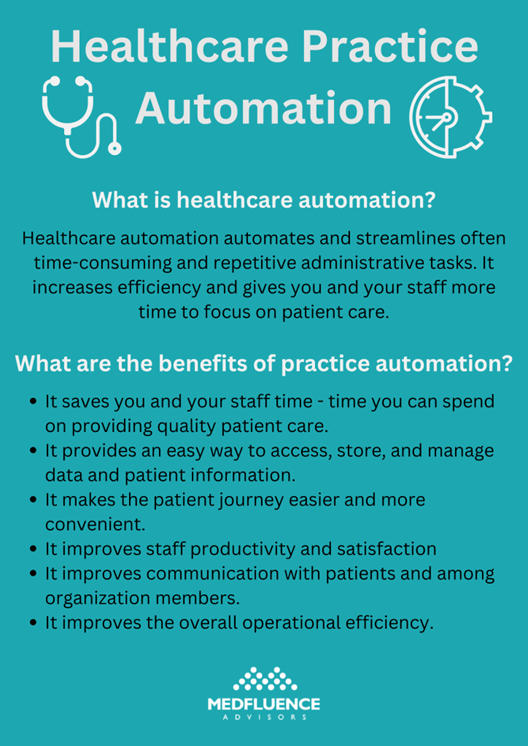
How Practice Automation Streamlines and Simplifies Business Operations
Now that you have an idea of all the benefits healthcare automation can do to your medical practice, what exactly are the aspects of your business that you can automate?
Patient Intake Process and Data Management
One huge aspect of patient onboarding is the patient intake process. When a patient starts their journey with your medical practice, they will need to fill in forms and provide the necessary information so you can do your job. This is a time-consuming task and often leaves your staff with a ton of paperwork.
Transitioning to digital intake forms will allow patients to fill in their information before they come in for their appointment. This will take them less time and will make it easier for your staff as well.
Additionally, using digital intake forms will provide your practice with a much easier way to store, track, and manage data and patient information.
Patient Booking and Scheduling
With practice automation, your business can now also automate patient booking and scheduling.
Gone are the days when patients would have to call or come into your office during working hours to book schedules and appointments. Now, they can do it all online and digitally.
The right appointment scheduling software will not only automate the process but will automatically update your schedule so you or your staff don’t have to do it manually. This lessens the time spent on administrative tasks and leaves you with more free time to spend on patient care.
Appointment Reminders
Automation allows practice owners to set up a system that automatically reminds patients of their appointment schedules so they don’t miss them.
With traditional and manual appointment booking systems, it is usually up to the patient to remember and keep track of their schedules. This can lead to many missed appointments, which is not good for both your patient’s health and your business.
Having an automated setup to remind patients of their upcoming schedules will decrease missed appointments.
Recall Lists
Most of the time, your patients will need to come back for follow-up appointments and check-ups. This ensures that treatments are progressing well and that your patients are in perfect health following their recent appointment with you.
Patients often forget their follow-up schedules, causing challenges for both them and your staff in tracking timely check-ups. Thankfully, practice automation offers a simple solution. You can configure the system to remind both patients and yourself about upcoming appointments on your calendar.
Payment, Billing, and Insurance
Many medical practices have embraced automation for payment collection, billing, and insurance processing. By setting up a system to automatically send payment reminders to patients after their appointments, they can conveniently fill out forms and submit payments on their own.
This automation reduces the manual workload on your staff, freeing up their time to focus on other critical tasks.
Feedback and Review Surveys
Positive reviews from previous patients significantly enhance the trustworthiness of a medical practice. This underscores the importance of gathering and showcasing feedback to foster business growth.
Unfortunately, not all patients will voluntarily leave reviews and feedback for your business.
To address this, implement an automated system that sends messages containing feedback and review survey links. This encourages patients to share their experiences with your organization. Moreover, the automated system in place will automatically collect the responses and you will have easy access to them.
This approach will not only enhance trust in your community but also provide insights into areas where your practice can improve and excel further.
Marketing Campaigns
Your healthcare practice is a business. This means marketing campaigns can go a long way to get your messaging across target audiences.
One way to get your business in front of the right audience is through sending emails, texts, and messages. This is often a tedious and time-consuming task and could take a toll on your workflow.
With automated systems, you can draft the message and choose specific dates and times when the message will be sent out. Now, that is one less important task off your list.
Staff Scheduling and Workflow
Transitioning staff scheduling into the digital and online world is a very flexible and convenient solution for many businesses.
You can create digital schedules for you and your staff that are very easy to edit and automate. Everyone within the organization can also have easy access to this digital schedule so everyone knows everyone’s schedule, increasing efficiency and promoting better workflow.
Implementing Practice Automation: The Ultimate Guide in 2024
If your practice has always used traditional operating systems, transitioning to practice automation can be daunting. The good news is, it doesn’t have to be because you don’t have to do every automation at once. You can start small and where it matters the most.
The question is, how can your practice start this transition? Here’s how you can do it:
1. Identify the challenges your practice is currently facing
The first step towards practice automation is to identify the big challenges your practice is currently facing. This can be anything that you and your staff are facing daily.
Are you and your staff spending too much time on paperwork? Do billing processes take too long? Is your organization having a hard time acquiring new patients and retaining old ones? Or is it the marketing and advertising side that’s giving you a hard time?
All of these challenges help run your business but can add up at the end of the day.
2. Identify the systems that relate to the challenges you’ve identified
Next, identify the systems that relate to and touch the challenges you’ve just identified in the first step.
This can be patient intake forms, feedback and review survey forms, billing software, Electronic Health Records (EHRs), and even the simple Google Spreadsheet.
Then, see if some of the problems in Step 1 span across multiple systems here.
3. Measure the time you spend on repetitive administrative tasks
To further help you identify your most pressing issues, measure the time you spend in a week on repetitive administrative tasks.
This step will help you realize that just because these tasks only take a few clicks here and there, they definitely add up at the end of the week.
4. Prioritize the business problems you want to solve
Now that you have your business issues in a clear list, ask yourself what your biggest priority is. Think of the number one issue you’d want to solve first that would save you the most time.
Is it patient booking and appointment? Or should you prioritize patient intake forms instead?
Don’t worry about the rest of your list for now. List them all according to priority based on how much time resolving each will save you. Place the most critical issues at the top for immediate attention.
5. Start your automation journey (slowly)
Once you’ve sorted out your business challenges and which one you should focus on, start your automation journey. Don’t get overwhelmed though! Start your automation journey slowly. There’s no need to rush things. Do it one problem at a time to give you and your staff some breathing room.
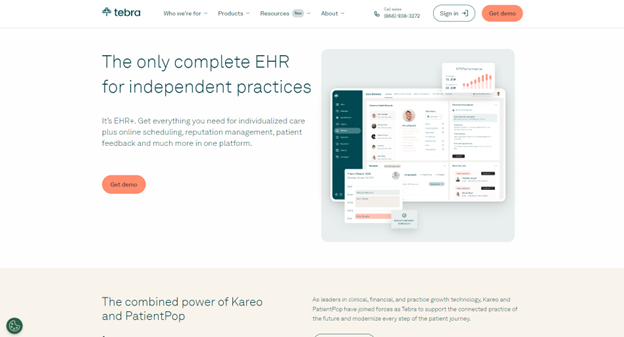
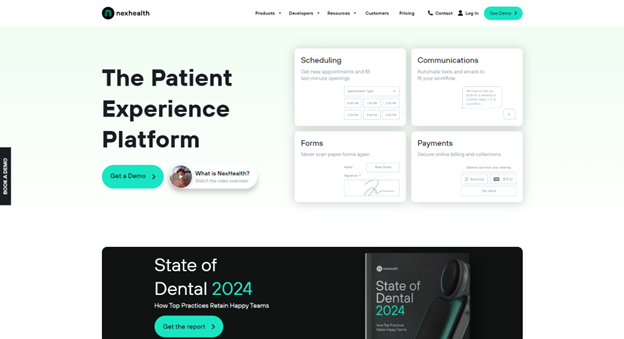
Automation systems like Tebra, Emitrr, Jotform, and NexHealth all help in a variety of ways and you have to find one that works best for your practice.
Practice Automation: A Continuous Process
Practice automation is an ongoing process because healthcare is constantly evolving.
If you’ve always used traditional systems in your medical practice, it may seem daunting to transition to system automation – but it definitely doesn’t have to be!
And with all the benefits practice automation has to offer, it shouldn’t be a question at all!
